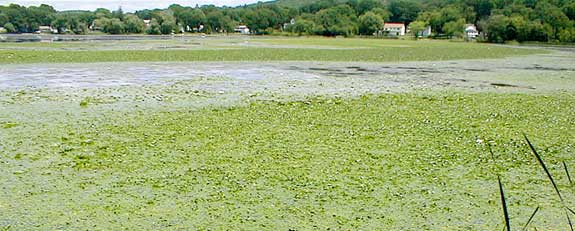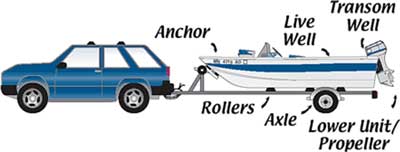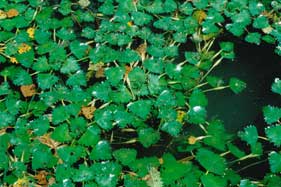News & Information
Please select a year.
No Hitchhikers Allowed
No Hitchhikers Allowed
By: Tim Clancy
Ah October, that's one of the best times to enjoy the lake and pursue the vast fishing opportunities, as the trophies that lurk below begin to fatten for the coming winter. Unfortunately, we're not going to discuss the great fishing, beautiful fall colors and how pleasant the lake becomes as the big boats begin their hibernation.
Because, once again our lake is threatened by another environmental hazard that we really need to be prepared for and work diligently to, first, make sure it never reaches our shores, but also be prepared to take action if it should. This is another non-native invasive aquatic plant that I have personally witnessed and I can only describe its impact is nothing less than frightening. Its called water chestnut (trapa natans) and it is well established just down stream in Lake Musconetcong where about 20% of that lake's surface (along the south east shore) is totally covered and completely un-navigable. This plant was first identified there just three years ago and has already had a devastating impact. It is known to multiply 10 fold a year and can achieve virtual monoculture (meaning it chokes out all other plant species) in five years. But this is not about a threat from Lake Musconetcong, but about very dangerous plant species. If it is in any New Jersey lake it could find its way here. It has also been found in the Hudson River and Lake Champlain. We don't want it here.

As a floating aquatic it can block out nearly all sunlight. That displaces other more desirable native plants, which can result in fish kills from depleted oxygen level and also facilitate algae blooms. Look at this photo taken at Lake Musconetcong and imagine trying to boat, swim, fish, ski or sail in a cove where this plant has become well established.
We need to take an aggressive approach with a program to assure our lake never experiences any of this. I'm going to coin the term A.I.R. (Avoid, Identify & Report) so the entire lake community can understand what to do, and it is going to take real vigilance and a lifetime commitment to keep this unwanted visitor out of our lake. Probably close to 1/3 of our lake has what would be ideal habitat for this uninvited guest to take up residence. It does very well in shallow (up to 8 feet) sluggish, nutrient rich fresh waters that have a soft substrate and full sun. Once established it is nearly impossible to totally eradicate, once its seeds are dropped they can lie dormant for up to ten years!
How can we Avoid the introduction to our lake? The BMPs (Best Management Practices) that are recommended to boaters to reduce the risk of introducing all undesirable hitch hikers will help us avoid this nasty little critter. From other non native invasive plants like Eurasian Milfoil (which is already well established in our lake), to other non native life forms like the Zebra Mussel and to pathogens like LMBV (Largemouth Bass Virus) VHS (Viral Hemorrhagic Septicemia), the BMPs used to avoid them will help us in our efforts with Water Chestnut.
So let's review these BMPs, first to make sure we don't bring hitchhikers to our lake, but also to make sure we don't transport them to other water bodies. When trailering your boat from lake to lake follow these simple procedures and we can reduce the risk of spreading many of these threats.
After getting your boat on its trailer, give the boat and the trailer a thorough once over and remove any vegetative matter. It's not just the hull you should be inspecting, but all areas on the trailer (see drawing). Next be sure to empty and dry out live wells and bilges. Not for this particular threat, but more for the dangerous pathogens like VHS and LMBV clean the bilges and live wells with a solution of one gallon of water mixed with one ounce of bleach. Then thoroughly dry these areas. Also, never release fish caught or bait purchased from one body of water into another. It's always a good idea to let the boat sit on the trailer for at least five days between launches.

It's not just anglers but all boaters who should learn and use these simple practices. These hitch hikers don't discriminate. They'll hitch a ride on a jet ski, sail boat, ski boat or classic wooden boat. So as we check our equipment, like nets and anchors, other boaters should check all their gear that comes in contact with the water. That's why it's best to let everything dry out for five days before launching in another body of water.
How can I Identify this specific plant species? While we strive to educate the public about avoiding introducing this plant, the reality is that with all our efforts it is still possible that it will eventually make it to our shores. Besides the boating public there are natural ways a species can be spread, aquatic birds could easily introduce it. Proper Identification is important because there are several similar native species of plants that are beneficial to the health of a lake and fish populations and we don't want to see them mistakenly destroyed. Also, there are very limited resources and we don't want to be wasting time investigating plant colonies that are not a concern. So be vigilant but learn to properly identify this specific plant, because if caught early it can be removed and the area monitored to limit re-infestation.

Water Chestnut is a floating aquatic with a triangular shaped leaf that is sharply serrated along both sides but the best way to distinguish from other similar floating aquatics is that the individual leaf is relatively small in size, generally less than 2 ½ inches wide. It quickly grows into a large mass of weed, blocking out sunlight, which can have a multitude of negative impacts on the environment. It also makes any recreational use of the area nearly impossible, so we really need to work together and not let this plant specie get established here at Lake Hopatcong.
Once I identify this plant who do I Report it to? While they are currently not adequately staffed or funded, the Lake Hopatcong Commission is where we should report any incidence of this plant at Lake Hopatcong. If they are not able to respond, they do have other resources they can contact at DEP. The Knee Deep Club is currently planning on having signs printed in time for next year's boating season and any other group or individual that wishes to reprint all or part of this information to disseminate to the lake community has the permission of the Knee Deep Club. Appreciation goes out to LHC Administrator Donna Macalle-Holly for her help with this article.

